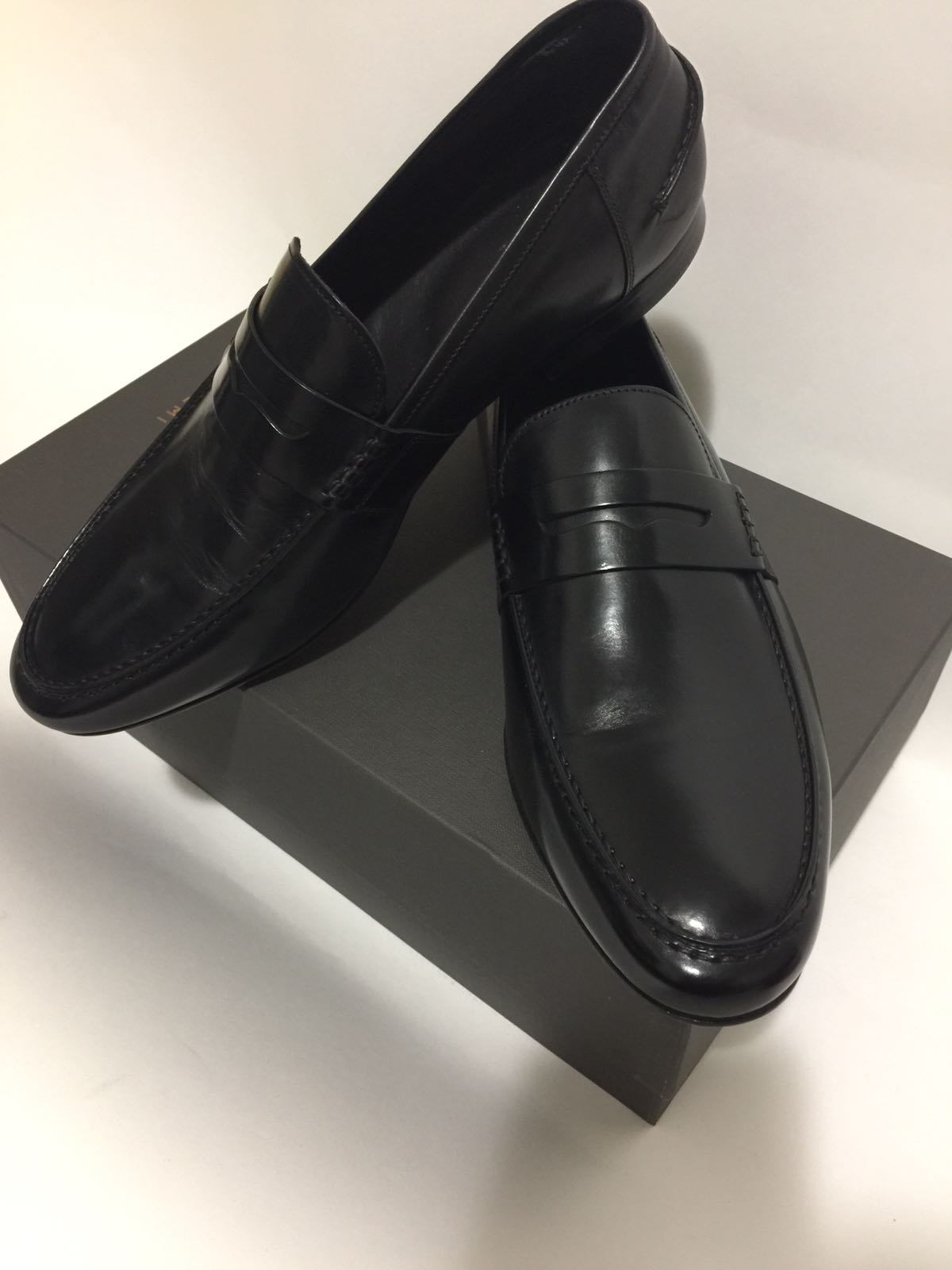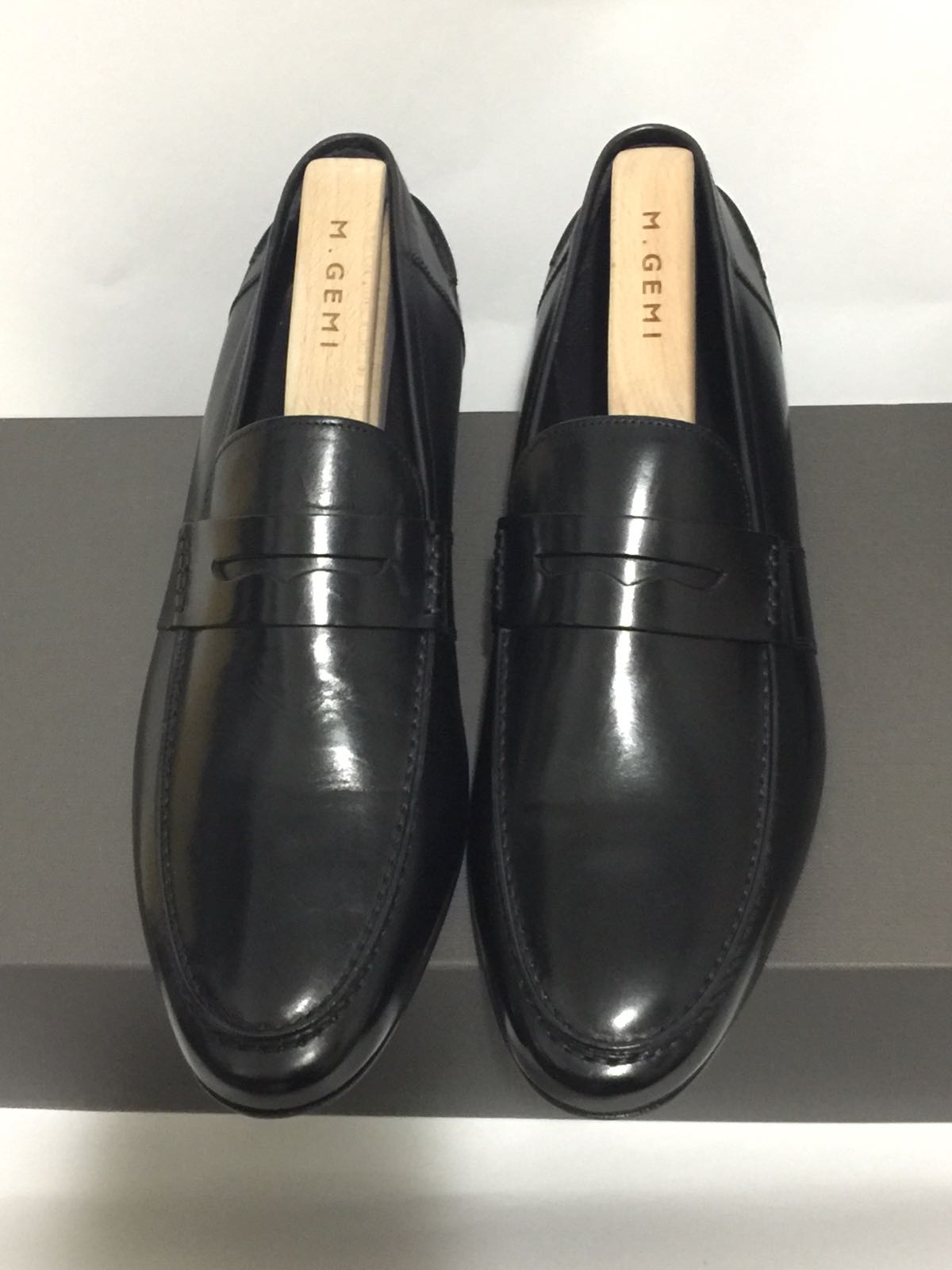I have been looking for a classy, comfortable and affordable black penny loafer for years. And apparently, I am not alone in this search. Many of my friends have also been on this fruitless hunt.
Every once in a while I find something that seems perfect, only to be bitterly disappointed once I try them on or get them in the mail. They either look a lot worse in person than they do online, feel terrible, don’t fit, or suffer from some other major shortcoming. So, I had sort of given up on finding that perfect black penny loafer. But after a friend recommended that I check out the gorgeous-looking M. Gemi black “Volo” loafers, I caved into temptation and decided to order myself a pair. M. Gemi has lots of incredible-looking shoes, and this one in particular is their “Best-selling Loafer.”
(If you’ve heard of M. Gemi before, then feel free to skip this next paragraph.)
M. Gemi is a direct-to-consumer shoe company that launched less than 3 years ago with women’s shoes, and then launched a men’s collection last year. Their goal (like many direct-to-consumer startups) is to sell Italian-crafted shoes for half of the price that similar shoes go for, and deliver it to your door expeditiously. They also release a brand new pair of shoes each and every Monday! In all, it’s pretty cool and exciting stuff. Of course, as I’ve learned, this is all only in theory. So, how is M. Gemi in reality?
The Ordering Process
E-commerce brands have gotten really good at bringing the in-store experience to an online platform, but, for obvious reasons, doing that for a shoe store is a bit more difficult. However, M. Gemi does as good a job as any on their website. I felt completely comfortable “getting to know” the shoes I was perusing since their copy is very informative and their shoe grouping (drivers, sneakers, loafers, oxfords, and boots) made it easy for me to compare their various loafer options, like looking at a shelf of loafers in-store.
I ordered the loafers on Wednesday, October 18th, and it shipped that day and arrived two days later on October 20th. Very impressive for a non-Amazon-Prime company! Moreover, shipping and returns are both free, so they really make the “try at home” experience pleasant, a la Zappos.
Packaging
M. Gemi really did an excellent job with their packaging. The shoe box is solid and it even comes with pretty decent shoe trees! I usually buy my shoe trees for around $20, so getting shoe trees essentially for free was a very pleasant surprise. This add-on truly separates them from many of the other shoemakers in their category (whom at best will throw in a shoe bag), so A+ on this for M. Gemi.
Bottom line: If I am paying a few hundred dollars for an item, I certainly expect that the un-packaging experience will be an elegant one – and M. Gemi certainly nailed it (unlike some of the other companies we have reviewed).
Quality & Construction
The single most important factor in how long a shoe will last, how good the quality is, and how much it costs is how well they are constructed. Construction is more important in a shoe than in almost any other item of clothing, as no other item takes the wear-and-tear quite like a shoe does.
For starters, as stated in the introductory paragraph, M. Gemi’s shoes are made in Italy, which is certainly a general indicator of high-quality (think Italian suits). Moreover, these Volo loafers are Blake welted/stitched, which is a lot better than a cheaper cemented attachment, but obviously not as good as Goodyear welting (pun intended; deal with it). That being said, the obvious advantage to Blake stitching over Goodyear is that it is cheaper. Both can be resoled, though the former not as easily. With these M. Gemi shoes, you are getting lots of bang for your buck overall, as we will see, but still keeping the prices reasonable with all that makes Goodyear welting impossible.
The upper is made out of hand-antiqued calfskin and there’s an all-leather lining, footbed and sole. The penny detail is hand-stitched and the penny strap continues all the way to the welt. I really like the long penny strap, though I’m aware that this extended strap is a deal-killer for some. It really does make the penny loafer look a bit untraditional, so make sure you recognize that this isn’t just another regular penny design. M. Gemi has added their flare to it. The leather is super soft and supple and truly feels like a $500 shoe.
In sum, the quality and construction of this shoe is freaking amazing and it has the same sexy look in person as it does on M. Gemi’s website. I’m very impressed with the super high quality of this shoe.
(Side Bar: As you may know, it is impossible to do Blake welting by hand. So I was a bit surprised and confused when I saw the following on M. Gemi’s site: “Refined details, done by hand—like sewn-edge seams, Blake stitching construction, and ... —set the Volo apart.” Tell me if you read this differently, but it certainly reads to me like they are saying that their Blake stitching construction was done by hand. I let the chat bot/person know that this was misleading, so hopefully they will change this language.)
Allen Edmonds vs. M. Gemi
Allen Edmonds has always been, and remains, the entry-level gold standard for high-end shoes. And deservedly so. They consistently deliver high-quality shoes at (semi) affordable prices, especially if you buy factory seconds (which I always do). So when assessing M. Gemi’s penny loafer, I find it necessary to compare it to Allen Edmonds to give a better sense of where these shoes fit on the spectrum, and what sort of person they are for.
Now, Allen Edmonds has a wide variety of penny loafers, so it’s hard to compare apples to apples. But, on a general level, there are two key differences to highlight. The first is the aesthetics: there’s no question that M. Gemi has got a sleeker look than AE, whose shoes are often built super sturdy and tank-like, but look a bit thicker and at times clunky. In fact, there’s literally not a single pair of AE penny loafers that look “sleek” or “cool.” They all look boxy and kind of old school. The second difference is that M. Gemi’s leather is very soft and supple which makes it a very lightweight shoe, while Allen Edmond’s loafers are much heavier and sturdier, and break in and mold to one’s feet over time. In a way, the M. Gemi loafer feels a bit “unconstructed” (I kind of hate that word, but it works here), while AE’s loafers are far more rigid.
Lastly, I should mention here that Allen Edmonds has many more sizing options for each shoe than M. Gemi does, as will be discussed below. This isn’t even a close battle so we won’t spend much time on it.
In sum, think of Allen Edmond as “ol’ reliable grandad” shoes, and M. Gemi as the flashy, but classy young neighbor. Both great shoes, but M. Gemi will certainly evoke a “where’d you get those shoes from?”, from the observant friend more than AE will.
Fit & Sizing
Okay, here’s where things got disappointing.
As many of you know, it’s important that loafers be just a bit more snug than lace-up shoes, since otherwise there will be some heel slippage and there are no laces to tighten to keep your foot in place. Thus, it is very common to go down half a size (or sometimes even a full size) when buying loafers. This way, although in the beginning it may be a bit tight, after a few wears it will get a bit looser while still staying snug. So, although I am an 11E shoe for my lace-ups, I have always gone down to a 10.5E for loafers.
Armed with this knowledge, I engaged the chat function on the M. Gemi website which promised to give me a “2-MINUTE FIT CONSULT.” I told the chat bot that 10.5E was my usual loafer size, and was wondering which “Italian” sizing would be best for the Volo loafer given my sizing and width requirements especially. The chat bot (or person) responded, and I quote, “I would try the 43.5 in the Volo, they do run a bit large so this should be perfect for your width.” The chat bot/person sounded pretty confident, no? Well, it was wrong. The shoe was way too tight for me. I could barely get it on my foot even with a shoe horn. There’s no way that these shoes “run a bit large.” Does M. Gemi truly think that their sizes “run a bit large”? Yes! How do I know? Because on their website, they give a “Fit Tip” for this shoe and they say, “This style runs a little large; we suggest ordering a half size down for the best fit.” But these shoes were only about as wide as an Allen Edmonds’s “D” width, and they are definitely not “a littler large.” I suggest you ignore this “fit tip” and instead consider this shoe a standard D width and normal 10.5 length.
Another disappointing experience on my hunt for elegant, well-fitting black loafers. These shoes are heading back to M. Gemi shortly.
Value for the Price & Conclusion
For starters, by signing up to receive their emails I received a cool $25 off to apply within one weeks’ time. So, although the list price is $248 (on that note, kinda odd that they didn’t just bump it to $249), I only paid $223. Considering the incredible quality and construction of this loafer, I think that $223 is a really great price for the value received. In short, if you're looking to add some high quality, super sleek-looking shoes to your wardrobe — and haven't been able to find that look from brands like Allen Edmonds — this is a great place to start.
Yes, spending $200+ on a pair of loafers is no small expense, but these are the kind of reliable quality shoes that I would keep for many years. Thus, if you are a “D” width, and have fairly normal feet, I’d definitely suggest giving M. Gemi a try. My only complaint is the fit, which doesn’t quite speak to “value” and doesn’t take away from the quality of this shoe, though I do certainly hope that M. Gemi will expand their sizing options to be more like Allen Edmonds in terms of offerings, so someone like me can get into a pair of these. In fact, I would think that having a wider variety of their core shoes would be better for their sales than releasing a new shoe each Monday. But what do I know?






